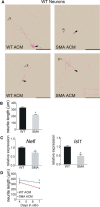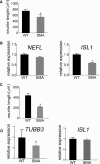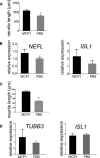Decreased Motor Neuron Support by SMA Astrocytes due to Diminished MCP1 Secretion
- PMID: 28450545
- PMCID: PMC5456111
- DOI: 10.1523/JNEUROSCI.3472-16.2017
Decreased Motor Neuron Support by SMA Astrocytes due to Diminished MCP1 Secretion
Abstract
Spinal muscular atrophy (SMA) is an autosomal-recessive disorder characterized by severe, often fatal muscle weakness due to loss of motor neurons. SMA patients have deletions and other mutations of the survival of motor neuron 1 (SMN1) gene, resulting in decreased SMN protein. Astrocytes are the primary support cells of the CNS and are responsible for glutamate clearance, metabolic support, response to injury, and regulation of signal transmission. Astrocytes have been implicated in SMA as in in other neurodegenerative disorders. Astrocyte-specific rescue of SMN protein levels has been shown to mitigate disease manifestations in mice. However, the mechanism by which SMN deficiency in astrocytes may contribute to SMA is unclear and what aspect of astrocyte activity is lacking is unknown. Therefore, it is worthwhile to identify defects in SMN-deficient astrocytes that compromise normal function. We show here that SMA astrocyte cultures derived from mouse spinal cord of both sexes are deficient in supporting both WT and SMN-deficient motor neurons derived from male, female, and mixed-sex sources and that this deficiency may be mitigated with secreted factors. In particular, SMN-deficient astrocytes have decreased levels of monocyte chemoactive protein 1 (MCP1) secretion compared with controls and MCP1 restoration stimulates outgrowth of neurites from cultured motor neurons. Correction of MCP1 deficiency may thus be a new therapeutic approach to SMA.SIGNIFICANCE STATEMENT Spinal muscular atrophy (SMA) is caused by the loss of motor neurons, but astrocyte dysfunction also contributes to the disease in mouse models. Monocyte chemoactive protein 1 (MCP1) has been shown to be neuroprotective and is released by astrocytes. Here, we report that MCP1 levels are decreased in SMA mice and that replacement of deficient MCP1 increases differentiation and neurite length of WT and SMN-deficient motor-neuron-like cells in cell culture. This study reveals a novel aspect of astrocyte dysfunction in SMA and indicates a possible approach for improving motor neuron growth and survival in this disease.
Keywords: MCP1/CCL2; astrocytes; iPSC; motor neuron; spinal muscular atrophy.
Copyright © 2017 the authors 0270-6474/17/375309-10$15.00/0.
Figures








Comment in
-
Effects of Astroglia on Motor Neurons in Spinal Muscular Atrophy.J Neurosci. 2017 Sep 6;37(36):8578-8580. doi: 10.1523/JNEUROSCI.1578-17.2017. J Neurosci. 2017. PMID: 28878096 Free PMC article. No abstract available.
Similar articles
-
Notch Signaling Mediates Astrocyte Abnormality in Spinal Muscular Atrophy Model Systems.Sci Rep. 2019 Mar 6;9(1):3701. doi: 10.1038/s41598-019-39788-w. Sci Rep. 2019. PMID: 30842449 Free PMC article.
-
Diminished motor neuron activity driven by abnormal astrocytic EAAT1 glutamate transporter activity in spinal muscular atrophy is not fully restored after lentiviral SMN delivery.Glia. 2023 May;71(5):1311-1332. doi: 10.1002/glia.24340. Epub 2023 Jan 18. Glia. 2023. PMID: 36655314
-
Astrocytes influence the severity of spinal muscular atrophy.Hum Mol Genet. 2015 Jul 15;24(14):4094-102. doi: 10.1093/hmg/ddv148. Epub 2015 Apr 24. Hum Mol Genet. 2015. PMID: 25911676 Free PMC article.
-
The Biochemistry of Survival Motor Neuron Protein Is Paving the Way to Novel Therapies for Spinal Muscle Atrophy.Biochemistry. 2020 Apr 14;59(14):1391-1397. doi: 10.1021/acs.biochem.9b01124. Epub 2020 Apr 2. Biochemistry. 2020. PMID: 32227847 Review.
-
Spinal muscular atrophy: antisense oligonucleotide therapy opens the door to an integrated therapeutic landscape.Hum Mol Genet. 2017 Oct 1;26(R2):R151-R159. doi: 10.1093/hmg/ddx215. Hum Mol Genet. 2017. PMID: 28977438 Review.
Cited by
-
Arsenic Impairs Differentiation of Human Induced Pluripotent Stem Cells into Cholinergic Motor Neurons.Toxics. 2023 Jul 25;11(8):644. doi: 10.3390/toxics11080644. Toxics. 2023. PMID: 37624150 Free PMC article.
-
PRMT inhibitor promotes SMN2 exon 7 inclusion and synergizes with nusinersen to rescue SMA mice.EMBO Mol Med. 2023 Nov 8;15(11):e17683. doi: 10.15252/emmm.202317683. Epub 2023 Sep 19. EMBO Mol Med. 2023. PMID: 37724723 Free PMC article.
-
Single-cell RNA sequencing reveals dysregulation of spinal cord cell types in a severe spinal muscular atrophy mouse model.PLoS Genet. 2022 Sep 8;18(9):e1010392. doi: 10.1371/journal.pgen.1010392. eCollection 2022 Sep. PLoS Genet. 2022. PMID: 36074806 Free PMC article.
-
Glial Cells in Spinal Muscular Atrophy: Speculations on Non-Cell-Autonomous Mechanisms and Therapeutic Implications.Neurol Int. 2025 Mar 13;17(3):41. doi: 10.3390/neurolint17030041. Neurol Int. 2025. PMID: 40137462 Free PMC article. Review.
-
Biological networks and complexity in early-onset motor neuron diseases.Front Neurol. 2022 Oct 21;13:1035406. doi: 10.3389/fneur.2022.1035406. eCollection 2022. Front Neurol. 2022. PMID: 36341099 Free PMC article.
References
-
- Andjelkovic AV, Kerkovich D, Shanley J, Pulliam L, Pachter JS (1999) Expression of binding sites for beta chemokines on human astrocytes. Glia 28:225–235. - PubMed
-
- Aït-Ikhlef A, Hantaz-Ambroise D, Henderson CE, Rieger F (2000) Influence of factors secrAieted by wobbler astrocytes on neuronal and motoneuronal survival. J Neurosci Res 59:100–106. - PubMed
Publication types
MeSH terms
Substances
LinkOut - more resources
Full Text Sources
Other Literature Sources
Medical
Research Materials
